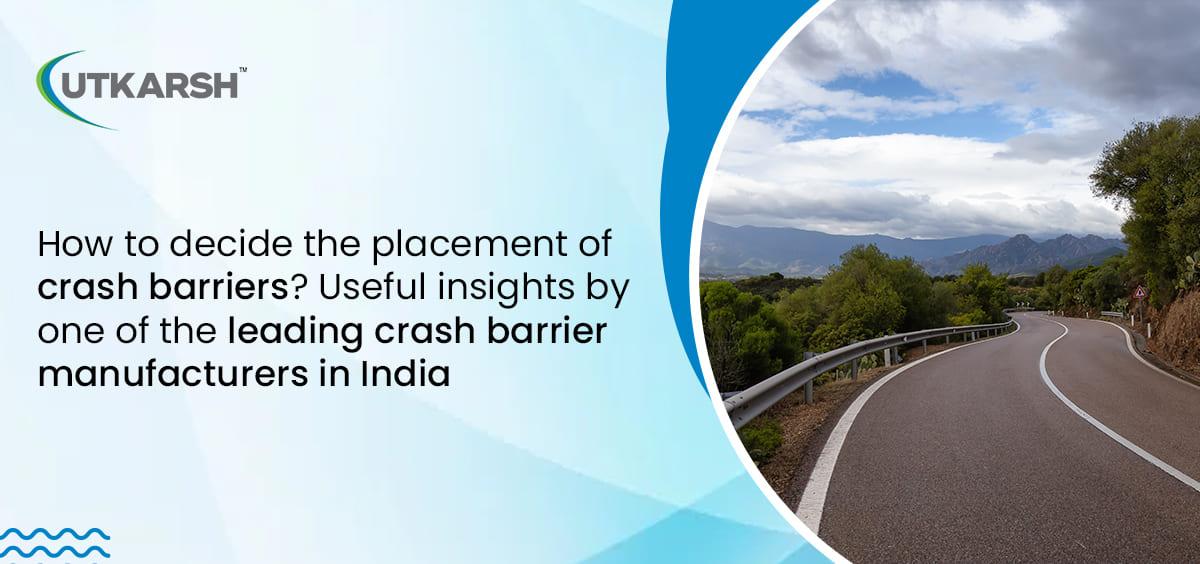How to decide the placement of crash barriers?

In India, where population density is high, road safety is of utmost importance. To reduce congestion and prevent road accidents, crash barriers are commonly used. These barriers are typically installed on highways, bridges and blind turns, and help guide traffic in a straight and designated path. They also absorb the effects of collisions, reducing the severity of damage caused to both vehicles and their occupants.
Before placing the crash barriers it is important to analyse the location of the installation - as the location will decide the selection and placement of the guardrails for the crash barrier system. Based on the location, a survey is carried out to analyse the important factors that are pivotal to determine the placement of the crash barriers.
As one of the leading crash barrier manufacturers in India, we discuss some of the useful insights on placement of crash barriers:
Environment :
The immediate environment of the road needs to be considered before placing a crash barrier. Consider if the crash barrier is being installed on a flat land, hilly region or in the coastal areas. The type of region will also determine the kind of climate of the area. For instance, if it is being installed in a hilly area, there are chances of snow or hailstorms. In such cases, it becomes important to select a crash barrier that is capable of withstanding extreme weather conditions.
Flow of traffic:
The flow of traffic determines the type and number of vehicles that pass through the particular route everyday. It indicates different aspects such as whether the vehicles carry large or moderate loads and the number of passenger vehicles. The crash barriers placed on roads with higher traffic volumes will be different from the ones that experience low to moderate traffic volumes.
Topography :
Topography, which comes from the Greek words "topo" for "place" and "graphia" for "writing," is the study of the surface features of the land. It provides a detailed description and mapping of the natural and man-made features of the land, such as mountains, valleys, rivers, and craters, which form the underlying foundation of a landscape.
The road's layout also plays an important role in deciding what kind of barrier to use. If the road is bendy or there are sharp turns or steep slopes, you need to select a crash barrier that can effectively guide traffic and prevent accidents..
Geological factors:
Geological factors include the type of soil adjacent to the roads. It determines if the soil is sandy, or consists of rocks. For instance, if the soil is sandy, it may not provide enough support to hold up a heavy crash barrier; this could lead to accidents if cars hit it at high speeds
It also considers the frequency of seismic activity in earthquake prone areas. The primary cause of earthquake damage is ground shaking, and many factors influence the strength of that shaking. Magnitude, proximity to the fault line and local geology are just some examples.
In earthquake-prone areas, crash barriers should be selected based on their ability to withstand earthquakes and other seismic events. This will require designing and installing structures that can withstand shaking and deformation caused by seismic activity.
Population density:
Before placing crash barriers, it is important to understand the density of population in a particular area. If the area is densely populated, it means that traffic volume and flow is more. The right kind of crash barriers should be chosen to enhance the safety of both pedestrians and vehicles.
Looking for reputed crash barrier manufacturers in India?
Explore Utkarsh India’s crash barriers. We offer a wide range of metal crash beam barriers such as::
- W beam crash barriers
- Thrie beam crash barriers
- Anchorage system
We have a manufacturing capacity of 12,000 MT/month and have a ready stock of minimum 50km at all times. Our fittings and components are manufactured, maintained and conforming to Indian, American, European and other international standards. Our raw materials are sourced from trusted brands such as SAIL, TATA and Hindustan Zinc. With a stringent quality control system, we ensure only the finest quality of products to our valued customers. We house four, 12.8 metre in-house galvanisation units. The crash barriers are hot dip galvanised in high grade zinc (99.99%) for a longer lifespan. The crash barriers are crash tested as per European standards. We also offer 24*7 logistic and dispatch department. To know more, get in touch with us.